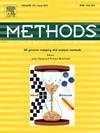RNA aptamer-induced fluorescence enhancement for NADH monitoring in cellular environment
IF 4.3
3区 生物学
Q1 BIOCHEMICAL RESEARCH METHODS
引用次数: 0
Abstract
Cellular redox homeostasis is tightly regulated by the oxidation–reduction reactions of nicotinamide metabolites, including NAD(H) and NADP(H), which serve as essential cofactors in enzymatic processes related to energy metabolism. Monitoring intracellular NADH levels is therefore of significant interest. Most chemosensor designs to date rely on fluorescence turn-on mechanisms triggered by NADH oxidation, but these reaction-based sensors are inherently limited by NADH concentration and reaction kinetics. While NADH exhibits intrinsic fluorescence, its low quantum yield has led to the development of redox-sensitive substrates that emit fluorescence upon NADH oxidation. Here, we report an alternative fluorescence enhancement strategy based on an NADH-binding RNA aptamer. The interaction between NADH and a 49-base-pair RNA aptamer induces a 1.4-fold increase in fluorescence emission in vitro and an 1.8-fold increase in live-cell imaging. This fluorescence enhancement arises from aptamer-induced structural rigidity, analogous to the mechanism by which 4-(p-hydroxybenzylidene)-5-imidazolidinone (HBI) enhances fluorescence in green fluorescent protein. Using our aptamer-based assay, we established a live-cell fluorescence emission assay for real-time monitoring of cellular NADH dynamics.
RNA适体诱导的荧光增强用于细胞环境中NADH的监测。
细胞氧化还原稳态受到烟酰胺代谢物氧化还原反应的严格调控,包括NAD(H)和NADP(H),它们是与能量代谢相关的酶促过程中必不可少的辅助因子。因此,监测细胞内NADH水平具有重要意义。迄今为止,大多数化学传感器设计依赖于NADH氧化触发的荧光开启机制,但这些基于反应的传感器本质上受到NADH浓度和反应动力学的限制。虽然NADH表现出固有的荧光,但其低量子产率导致了氧化还原敏感底物的发展,这些底物在NADH氧化时发出荧光。在这里,我们报告了一种基于nadh结合RNA适体的替代荧光增强策略。NADH与49碱基对RNA适体之间的相互作用诱导体外荧光发射增加1.4倍,活细胞成像增加1.8倍。这种荧光增强是由适配体诱导的结构刚性引起的,类似于4-(对羟基苄基)-5-咪唑烷酮(HBI)增强绿色荧光蛋白荧光的机制。利用我们基于适配体的实验,我们建立了一个活细胞荧光发射实验,用于实时监测细胞NADH动力学。
本文章由计算机程序翻译,如有差异,请以英文原文为准。
求助全文
约1分钟内获得全文
求助全文
来源期刊

Methods
生物-生化研究方法
CiteScore
9.80
自引率
2.10%
发文量
222
审稿时长
11.3 weeks
期刊介绍:
Methods focuses on rapidly developing techniques in the experimental biological and medical sciences.
Each topical issue, organized by a guest editor who is an expert in the area covered, consists solely of invited quality articles by specialist authors, many of them reviews. Issues are devoted to specific technical approaches with emphasis on clear detailed descriptions of protocols that allow them to be reproduced easily. The background information provided enables researchers to understand the principles underlying the methods; other helpful sections include comparisons of alternative methods giving the advantages and disadvantages of particular methods, guidance on avoiding potential pitfalls, and suggestions for troubleshooting.
 求助内容:
求助内容: 应助结果提醒方式:
应助结果提醒方式:


